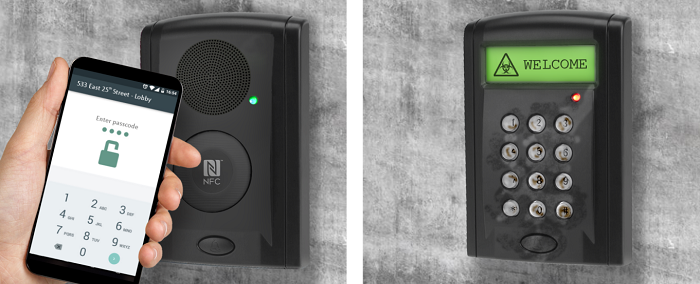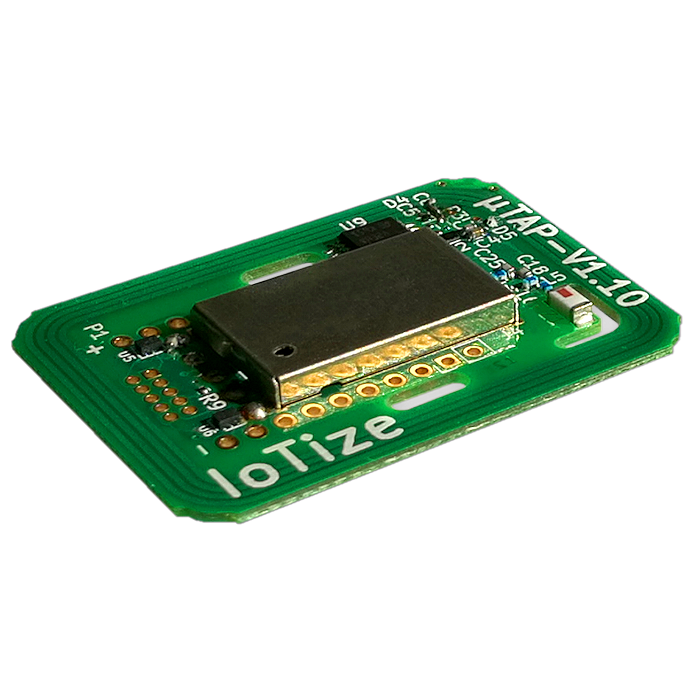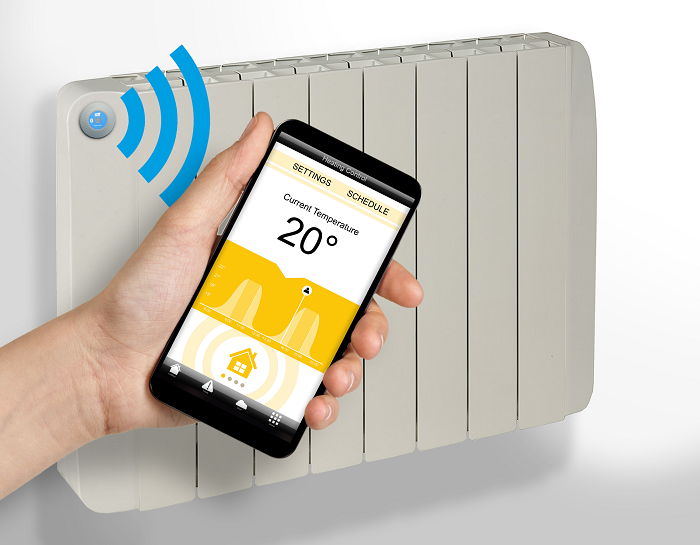By Francis Lamotte, president, IoTize SAS
On a daily basis, we touch and manipulate control screens, keypads, or buttons that may be handled by tens, hundreds, or even thousands of other users. In our worldwide battle to contain the coronavirus, or Covid-19, we’ve all become increasingly shy of public spaces and the many things that we all touch.
Initial study results indicate that the Covid-19 virus can be detected from several hours to up to three days on a surface,1 which only reinforces the sentiment that tactile screens, keypads, and even simple buttons are “suspect” once they have been in contact with others.
This observation supports at least the mitigation of risk,2,3 if not the outright elimination of shared objects and surfaces in public spaces. Bars, handles, doors, and other handhelds certainly present the highest risks. Cash and coins that circulate freely, person to person, are also suspect. Payment terminals, kiosks, panels for key code entry, and buttons likewise stand out as vectors of contamination.

Fig. 1: A proposed mobile app for replacing a keypad entry system (Image: IoTize SAS)
Mobile & apps can replace shared on-board controls
By reducing the shared touching of panels, buttons, or switches, mobile apps remove one common vector of disease transmission, as well as provide other advantages for users and equipment manufacturers. Why not supplant mobile devices as our dedicated interfaces in place of shared on-board interfaces?
The mobile phone is certainly the best candidate for offboarding any shared tactile screen. The large majority of the public carries these personal tactile screens with them at all times and is intimately familiar with their features and ease of use. They are our personal appliance and rarely, if ever, passed from person to person. They are certainly easier to clean than any keypad. In comparison, the shared tactile screens on other equipment are sometimes outdated, difficult to understand, and “suspect” from a sanitary point of view.
The key challenge in the transition to mobile is how to associate the equipment with the right interface app. The technology to do this easily and seamlessly does exist. With near-field communication (NFC), simply approaching a system with an NFC-enabled device can launch the appropriate app and establish a secured communication channel. And communication can continue by NFC or be handed off to another wireless channel such as Bluetooth or Wi-Fi.
Already today, products are emerging that employ this intuitive, secure technology for a variety of uses that include everything from pairing devices and configuring appliances to starting machines or opening doors.
Thanks to evolutions in iOS and Android, NFC now offers very similar features regardless of the type of mobile phone. NFC mobile phones can collect information stored in static NFC tags.
They can also easily serve in complex uses like retrieving an appliance’s configuration and modifying it. For example, programming electric radiators becomes remarkably easier when using a mobile app than when using the LCD/pushbutton interface that they are typically equipped with.
For door or gate access codes, no need to fiddle with keypad entry. Tap to open the correct app. Enter the code on the mobile. Tap to transmit the code.
Want a coffee from a public distributor? Tap the phone to the NFC indicator on the distributor to get the app. Select the drink and then pay using a preset payment mechanism like a payment card or debit from a mobile account. A second tap to confirm the transaction, and your coffee is on the way.
In all of these examples, contactless technology and mobile apps considerably reduce physical contact between the user and surfaces that present a risk of contamination. NFC advantages include:
- It is intuitive for the user: Just approach the mobile to the NFC indicator to get the right app and to communicate.
- It is secure: Communication occurs over short range, limiting the possibility of eavesdropping and key theft.
- It is dynamic: It can serve as a two-way channel to retrieve information and to write information to an electronic system.
Does contactless mean zero risk?
Contactless technology eliminates much of the need for physical contact between a person and a surface. NFC is derived from the contactless technologies used in payment cards. In a card (also referred to as a “tag” or a “passive device”), the device includes an antenna that couples with the magnetic field of a reader.4 This coupling requires no physical contact — having a reader and a passive device in proximity (~3–5 cm) is sufficient for establishing a connection and communication. This eliminates the need for physical contact between two NFC devices.
In practice however, “contactless” does not translate to “zero risk.” When we pay with a contactless card, we often approach the card to the payment reader to a point where the card contacts the surface of the reader. The same is true for an NFC mobile phone. The contact is not necessary, but it is simply easier to rest the card or mobile on the surface of an NFC reader for the instant of the transaction.
All the same, in comparison to manipulating key controls or tactile displays, the duration and the pressure in the physical contact is much shorter. Contactless technology is not a “zero risk” solution, but it does considerably reduce risks.
Why isn’t NFC used more?
NFC began as a technology for payments and transportation access. Notably in Asia, NFC-enabled mobile devices are replacing the use of currency and physical tickets. However, NFC is much rarer in other equipment or electronic applications.
This is primarily due to the difference in the degree of access to NFC that system designers were given under iOS and Android. Prior to 2019, Apple had restricted NFC to payment applications. Android mobile devices offered greater access to NFC that enabled bidirectional communication, which made it interesting as an interface between mobile devices and other types of equipment.
However, the inability to provide users the same functionality on Android and iOS limited the interest of the technology. With the September 2019 release of iOS 13, Apple changed all this by removing their previous constraints on NFC.5,6
The other principal hurdle to NFC uptake has been the difficulty that engineers have had in assimilating the technology. NFC, because of its origins in the payment card industry, is fundamentally different from Bluetooth and Wi-Fi technologies, which are more commonly known to electronics designers. Today, a solution is available that vastly simplifies NFC implementation.
A rapid, easy path to NFC integration
Wireless modules that implement NFC alone or as a complement to other RF technologies like Bluetooth can greatly facilitate all aspects of integration: firmware integration, mobile integration, and qualification of the final design.
Wireless modules will typically include reference designs and code libraries to reduce the amount of code development required at the application level. These modules are qualified under relevant standards for their target markets.
Using a module constrains designers by limiting the possibilities to adapt certain aspects of implementation. For example, in a pre-qualified NFC/Bluetooth module, the designer won’t be able to change antenna design or broadcasting strength without doing a full recertification of the finished, wireless-enabled product. But the tradeoff to the constraint is the advantage in effort and time to deploy their finished product.

Fig. 2: A plug-and-play wireless module (Image: IoTize SAS)
A module called TapNLink takes this approach a step further. It includes pre-implemented wireless features (NFC bidirectional communication, NFC-Bluetooth device paring, configurable access control mechanisms, dynamic encryption, etc.) and supporting software for mobile integration and automatic app generation.
The idea behind the approach is to provide a solution that simplifies all aspects of a certain type of wireless implementation. Notably, it is designed for using wireless to interface appliances with mobile devices and their apps. The objective is to help companies master all of the expertise, risks, and costs that are associated with NFC integration — whether at the level of electronic design, embedded software design, or mobile app creation.
In this case, there is virtually no development to do at the firmware level. The modules are configured by an appliance designer to act as a monitor for the electronics in their system. The module actually seeks and can also replace (or write) specific data in the system’s processor. Seeking data allows an app to retrieve an appliance’s configuration or status. Replacing data reconfigures a system or controls actions, such as opening a gate or starting a motor.
The access can be constrained by the module’s configuration. For example, the possibility to change data (i.e., trigger actions) can be reserved for a user who has entered a password or a code.
The configuration is the basis for the automatic generation of iOS and Android mobile apps so that creating an offboarded user interface for a system is reduced to:
- Configuration of the module with the data to access and the access rights
- Selecting how data is represented in the app (graphs, gauges, texts, etc.)
- Clicking to generate the iOS and Android apps
The generated apps are based on a standard Cordova platform — nothing proprietary. System designers or web designers can easily tailor all generated code to meet the most specific needs like using the mobile’s GPS for geolocation.
Mechanisms for testing these apps on mobiles are also integrated in the configuration software environment. Designers can thus work rapidly, modifying their module’s configuration and viewing results in the software and on their mobiles.
By resolving the technical challenges of wireless integration and app development, wireless modules vastly reduce the effort required to create user interfaces as mobile apps. This makes the advantages of NFC contactless technology more accessible to appliance, equipment, and system designers who may have limited experience with wireless, access control, encryption, mobile apps, etc. It also shortens time to market.

Fig. 3: Proposed app for a radiator thermostat (Image: IoTize SAS)
Whether it is a question of reducing sanitary worries or improving functionality for users, offboarding user interfaces from appliances to mobiles is a winning proposition. Eliminating touchscreens and keypads removes transmission surfaces that turn most users off in the first place. Simplifying product control panels and moving to minimalist designs also make for appliances and equipment that are easier to clean and maintain, as well as remove hardware costs and logistic burdens for the manufacturer.
References:
1 Aerosol and Surface Stability of SARS-CoV-2 as Compared with SARS-CoV-1, New England Journal of Medicine, 17 March 2020, lettre à l’éditeur – Neeltje van Doremalen, Ph.D., Dylan H Morris, M.Phil., Myndi G. Holbrook, B.Sc., Amandine Gamble, Ph.D., Brandi N. Williamson, MPH, Azaibi Tamin, Ph.D., Jennifer L. Harcourt, Ph.D. , Natalie J. Thornburg, Ph.D., Susan I. Gerber, MD, James O. Lloyd-Smith, Ph.D., Emmie de Wit, Ph.D., Vincent J. Munster, Ph.D., https://www.nejm.org/doi/full/10.1056/NEJMc2004973
2 Tackling the spread of pathogens in transport hubs, Drug Target Review, 13 December 2016, Ilpo Kulmala, https://www.drugtargetreview.com/article/18013/pathogens-in-transport/
3 You Touch Public Surfaces All Day. Here’s How to Stay Safe From Coronavirus, Consumer Reports, 11 March 2020, Lindsey Konkel, https://www.consumerreports.org/coronavirus/touching-public-surfaces-how-to-stay-safe-from-coronavirus/
4 About NFC Technology, NFC Forum, https://nfc-forum.org/what-is-nfc/about-the-technology/
5 IPhone NFC Compatibility, Blue Bite, 23 March 2020, https://www.bluebite.com/nfc/iphone-nfc-compatibility
6 Changes in iOS-13 to boost NFC popularity, eeNews, 13 September 2019, Francis Lamotte, https://www.eenewseurope.com/news/changes-ios-13-boost-nfc-popularity
Advertisement
Learn more about Electronic Products Magazine





